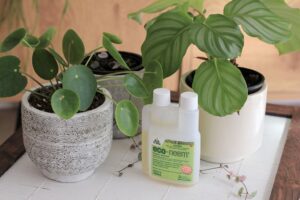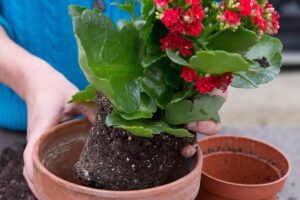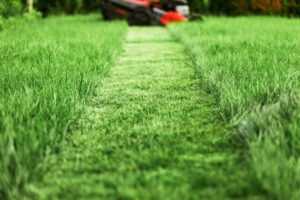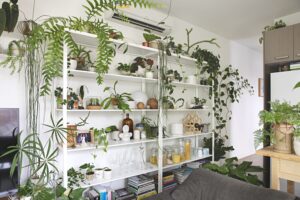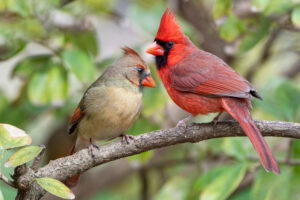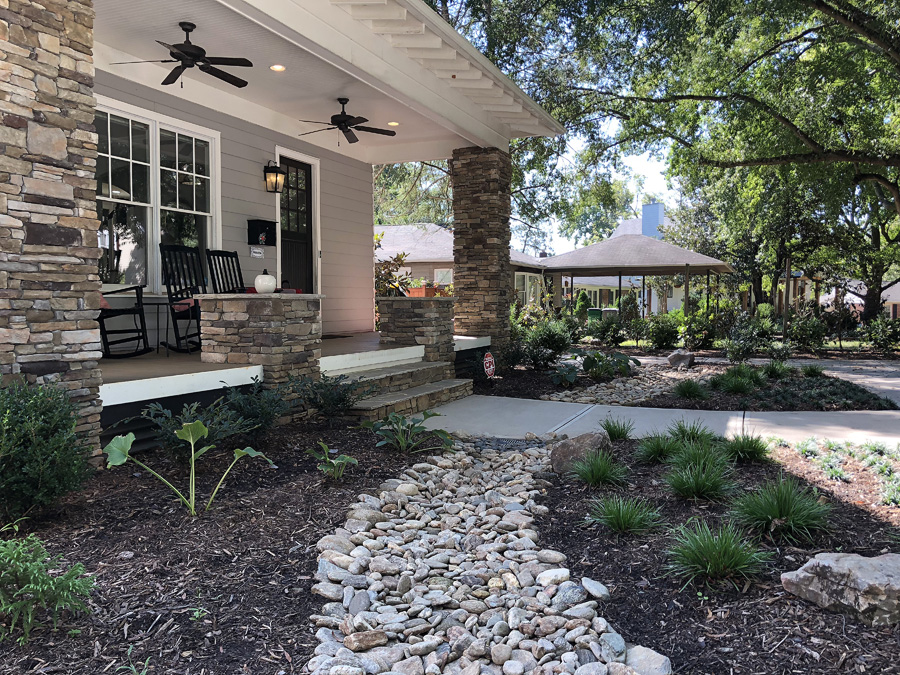
Front yard landscaping plays a crucial role in enhancing the curb appeal and overall aesthetics of a property. Among the myriad of design options available to homeowners, the incorporation of a dry river bed offers a unique and visually striking feature that not only adds beauty but also serves practical purposes. In this article, we explore the art and science of front yard dry river bed landscape design, from planning and construction to maintenance and inspiration.
**I. Introduction**
The practice of integrating dry river beds into front yard landscapes has been gaining momentum in recent years, driven by a desire for sustainable and low-maintenance outdoor spaces. These features mimic the appearance of natural riverbeds, utilizing rocks, pebbles, and drought-resistant plants to create a visually appealing and environmentally friendly design element. By channeling rainwater runoff and promoting drainage, dry river beds also offer practical benefits for managing water flow and erosion in the landscape.
**II. Planning and Preparation**
*Site Assessment and Analysis*
1. **Drainage Considerations**: Before embarking on the design process, it’s essential to assess the site’s drainage patterns and identify areas prone to water pooling or erosion. This information will inform the placement and layout of the dry river bed to ensure optimal functionality and performance.
2. **Existing Landscape Features**: Take stock of existing landscape elements such as trees, shrubs, and structures, and consider how the dry river bed will complement or integrate with these features. This holistic approach ensures harmony and cohesion in the overall design scheme.
*Design Concept and Theme*
1. **Naturalistic vs. Formal Designs**: Determine the desired aesthetic and theme for the dry river bed, whether it be a naturalistic, meandering streambed or a more formal, structured design. This decision will guide subsequent design choices and material selections.
2. **Integration with Surrounding Environment**: Aim to create a seamless transition between the dry river bed and the surrounding landscape, incorporating elements that reflect the local environment and complement the architectural style of the home.
*Material Selection*
1. **Choice of Rocks and Pebbles**: Select rocks and pebbles of varying sizes, shapes, and colors to mimic the natural appearance of a riverbed. Consider local availability and aesthetics when choosing materials for the dry river bed.
2. **Consideration of Plantings and Mulch**: Choose drought-tolerant plants and ground coverings that thrive in the local climate and require minimal maintenance. Mulch can help retain moisture and suppress weeds, enhancing the overall health and vitality of the landscape.
**III. Construction Process**
*Excavation and Shaping*
1. **Creating the Flowing Pathway**: Use a combination of excavation and grading techniques to sculpt the desired shape and contour of the dry river bed, ensuring smooth water flow and visual appeal.
2. **Building Depth and Dimension**: Gradually build up the depth and dimension of the dry river bed, layering rocks and pebbles to create depth and texture. Pay attention to the natural flow of water and mimic organic patterns and formations in the design.
*Installation of Hardscape Elements*
1. **Arrangement of Rocks and Boulders**: Arrange rocks and boulders in a naturalistic manner, varying their placement and orientation to create visual interest and realism. Consider using larger rocks as focal points or anchor features within the landscape.
2. **Incorporation of Pathway Materials**: Define the edges of the dry river bed with pathway materials such as gravel, pavers, or stepping stones. These elements provide structure and delineation while facilitating access and maintenance.
*Planting and Mulching*
1. **Selection of Drought-Tolerant Plants**: Choose a diverse selection of drought-tolerant plants and ground covers that thrive in the local climate and soil conditions. Arrange plants strategically along the banks of the dry river bed to soften edges and add color and texture.
2. **Mulch Application for Weed Control**: Apply a layer of mulch around plantings and along the surface of the dry river bed to suppress weeds and retain moisture. Organic mulches such as wood chips or bark nuggets are ideal for this purpose, providing insulation and nutrients to the soil.
**IV. Maintenance and Care**
*Seasonal Upkeep*
1. **Pruning and Trimming**: Regular pruning and trimming of plants and shrubs help maintain the desired shape and appearance of the dry river bed, preventing overgrowth and overcrowding.
2. **Mulch Replacement and Weed Management**: Periodically replenish mulch layers to ensure adequate coverage and weed suppression. Monitor the dry river bed for invasive weeds and promptly remove them to prevent competition with desirable plantings.
*Watering and Irrigation*
1. **Drought-Resistant Plant Care**: While drought-tolerant plants require less water than traditional landscaping, they still benefit from occasional watering during dry spells. Use drip irrigation or soaker hoses to deliver water directly to the root zone, minimizing waste and promoting efficient water use.
2. **Proper Watering Techniques**: Water plants deeply and infrequently to encourage deep root growth and drought resilience. Avoid overhead watering, which can promote fungal diseases and water runoff.
*Long-Term Preservation*
1. **Monitoring Drainage and Erosion**: Regularly inspect the dry river bed for signs of erosion or drainage issues, such as sediment buildup or water pooling. Address any issues promptly to prevent damage to the landscape and maintain proper functionality.
2. **Adjustments and Enhancements Over
Time**: As the landscape matures and evolves, consider making adjustments and enhancements to the dry river bed design to reflect changing preferences or environmental conditions. This ongoing maintenance ensures the continued beauty and functionality of the landscape for years to come.
**V. Inspiration and Ideas**
*Design Variations and Adaptations*
1. **Incorporating Water Features**: Enhance the visual appeal of the dry river bed by incorporating water features such as fountains, cascades, or recirculating streams. These additions add movement and sound to the landscape, creating a tranquil and inviting atmosphere.
2. **Combining with Other Landscape Elements**: Integrate the dry river bed with other landscape features such as gardens, patios, or seating areas to create cohesive outdoor living spaces. This holistic approach enhances the overall functionality and enjoyment of the landscape.
*Creative Themes and Styles*
1. **Desert Oasis Aesthetic**: Embrace the natural beauty of arid landscapes with a desert oasis-inspired dry river bed design. Incorporate succulents, cacti, and drought-tolerant grasses to evoke the ambiance of a desert retreat.
2. **Zen Garden Inspiration**: Create a sense of serenity and harmony with a Zen garden-inspired dry river bed design. Use minimalist elements such as smooth river rocks, raked gravel, and sculptural accents to evoke a sense of tranquility and mindfulness.
*Sustainable Practices and Eco-Friendly Options*
1. **Xeriscaping Principles**: Embrace xeriscaping principles such as water conservation, soil health, and native plantings in the design of the dry river bed. By prioritizing sustainability and environmental stewardship, homeowners can create beautiful and resilient landscapes that thrive with minimal water and maintenance.
2. **Native Plant Selections**: Choose native plants and grasses that are adapted to the local climate and soil conditions, reducing the need for supplemental watering and fertilization. Native plants also provide essential habitat and food sources for local wildlife, enhancing biodiversity and ecological resilience.
In conclusion, front yard dry river bed landscape design offers a creative and practical solution for homeowners seeking to enhance the beauty and functionality of their outdoor spaces. By carefully planning and implementing a dry river bed design that harmonizes with the surrounding environment and integrates sustainable practices, homeowners can create landscapes that are both aesthetically pleasing and ecologically responsible. Whether inspired by naturalistic riverbeds, formal garden aesthetics, or cultural themes, the possibilities for creativity and expression are endless in the realm of dry river bed landscaping.

